Animalia

Hawaiian Beet Webworm
Spoladea recurvalis

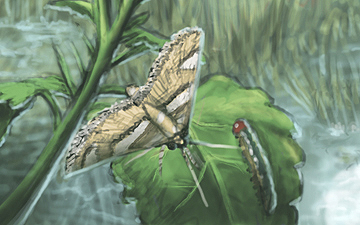
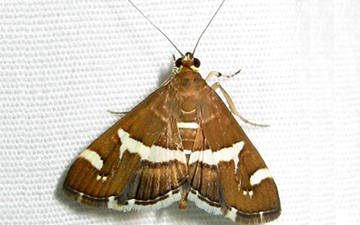
5 POINTS
• Spoladea recurvalis has a FLIGHT of 2.
• Spoladea recurvalis is considered a POLLINATOR
Warm, Hot
Graphic by S B Kennedywingedsonar.deviantart.com
Photo by Anita363www.flickr.com/photos/anitagould/
Spoladea recurvalis is a species of moth of the family Crambidae. It is found worldwide, but mainly in the tropics. The wingspan is 22-24 mm. The moth flies from May to September depending on the location. The larvae feed on Spinach, Beet, Cotton, Maize and Soybean. (From Wikipedia, May 18th, 2010) read more

Common Raven
Corvus corax

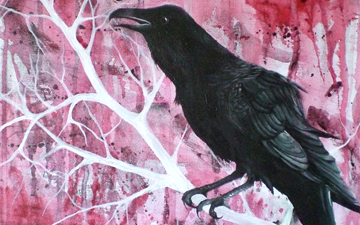

2 POINTS
• Corvus corax has a FLIGHT of 2.
• Corvus corax can inhabit any landbased terrain
Corvus corax is thought to be highly intelligent.
Cold, Cool, Warm, Hot
Graphic by Jesse Kemptondarkconofman.deviantart.com/
Photo by Anita363www.flickr.com/photos/anitagould/
The Common Raven (Corvus corax), also known as the Northern Raven, is a large, all-black passerine bird in the crow family. Found across the northern hemisphere, it is the most widely distributed of all corvids. There are eight known subspecies with little variation in appearance—although recent research has demonstrated significant genetic differences among populations from […] read more

Tiger Quoll
Dasyurus maculatus


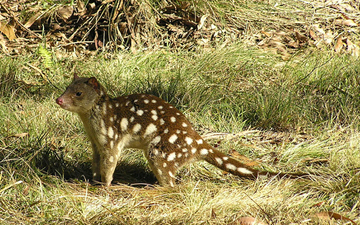
9 POINTS
• Dasyurus maculatus has a MOVE of 2.
“It is mainland Australia’s largest, and the worlds longest, carnivorous marsupial.”
Warm, Hot
Graphic by Leticia Rocha-Zivadinoviccreturfetur.com
Photo by Pierre Pouliquinwww.flickr.com/photos/pierre_pouliquin/
The tiger quoll (Dasyurus maculatus), also known as the spotted-tail quoll, the spotted quoll, the spotted-tailed dasyure or (erroneously) the tiger cat, is a carnivorous marsupial native to Australia. It is mainland Australia’s largest, and the worlds longest (the biggest is the Tasmanian Devil), carnivorous marsupial and it is considered an apex predator. The tiger […] read more

Spectacled Fruit Bat
Pteropus conspicillatus


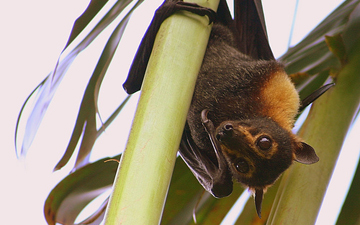
6 POINTS
• Pteropus conspicillatus has a FLIGHT of 2.
• Pteropus conspicillatus is a POLLINATOR and is a frugivore. They eat fruit.
Warm, Hot
Graphic by S B Kennedywingedsonar.deviantart.com
Photo by Shek Grahamwww.flickr.com/photos/shekgraham/
The Spectacled Flying-fox, Pteropus conspicillatus also known as the Spectacled Fruit Bat, lives in Australia’s north-eastern west regions of Queensland. It is also found in New Guinea and on the offshore islands including Woodlark Island, Alcester Island, Kiriwina, and Halmahera. The head and body length is 22–25 cm, forearm 16–18 cm, weight 400–1000 g. A […] read more

Western Sucker-footed Bat
Myzopoda schliemanni

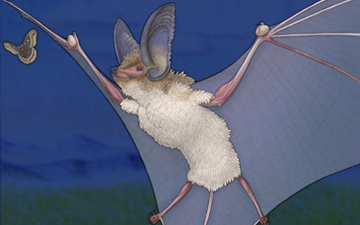
Sorry, there is no photo available. If you have one, please submit
here
.
8 POINTS
• Myzopoda schliemanni has a FLIGHT of 2.
Myzopoda schliemanni has “prominent suckers on its feet and thumbs.”
Warm, Hot
Graphic by S B Kennedywingedsonar.deviantart.com
The Western Sucker-footed Bat (Myzopoda schliemanni) is a Malagasy bat. Little is known about its habits, but they are assumed to be similar to those of the Madagascar Sucker-footed Bat.[1] The Western Sucker-footed Bat is 92-107 cm. (3-3.5 ft.) long. It has large ears, and prominent suckers on its feet and thumbs. It has buff-brown […] read more

Jamaican Fruit Bat
Artibeus jamaicensis

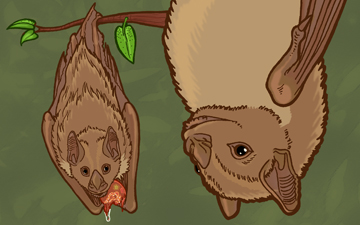
Sorry, there is no photo available. If you have one, please submit
here
.
6 POINTS • Artibeus jamaicensis has a FLIGHT of 2. • Artibeus jamaicensis is a POLLINATOR and is a frugivore. They eat fruit.
Warm, Hot
Graphic by S B Kennedywingedsonar.deviantart.com
The Jamaican, Common or Mexican fruit bat (Artibeus jamaicensis) is a fruit bat native to Central and South America, as well as the Greater and many of the Lesser Antilles. It is also an uncommon resident of the Southern Bahamas. Its distinctive features include the absence of an external tail and a minimal, U-shaped interfemoral […] read more